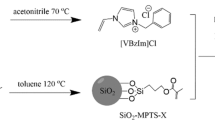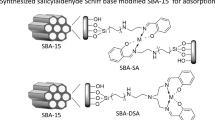Abstract
Amphiphilic double poly(imidazole ionic liquid) grafted silica (SMIL-n) was prepared by radiation grafting of hydrophilic 1-vinyl-3-ethylimidazolium bromide and hydrophobic 1-vinyl-3-octylimidazolium bromide at different ratio onto silica. The adsorption behavior of SMIL-n was investigated. The adsorption equilibrium could reach less than 45 min, and their adsorption capacity were 152–171 mg/g obtained from Langmuir model. The selectivity of SMIL-n to ReO4− increased with the increasing content of hydrophobic ionic liquid. SMIL-n displayed good reusability, excellent acid resistance and irradiation resistance. Particularly, SMIL-n showed promising for ReO4− uptake from simulated contaminated Beishan groundwater and radioactive wastewater.












Similar content being viewed by others
References
Wildung RE, McFadden KM, Garland TR (1979) Technetium sources and behavior in the environment. J Environ Qual 8:156–161
Valsala TP, Sonavane MS, Kore SG et al (2011) Treatment of low level radioactive liquid waste containing appreciable concentration of TBP degraded products. J Hazard Mater 196:22–28
Banerjee D, Kim D, Schweiger MJ et al (2016) Removal of TcO4- ions from solution: materials and future outlook. Chem Soc Rev 45:2724–2739
Wang Y, Wang C (2018) Recent advances of rhenium separation and enrichment in China: Industrial processes and laboratory trials. Chinese Chem Lett 29:345–352
Ogata T, Takeshita K, Tsuda K, Mori A (2009) Solvent extraction of perrhenate ions with podand-type nitrogen donor ligands. Sep Purif Technol 68:288–290
Neeway JJ, Asmussen RM, Lawter AR et al (2016) Removal of TcO4- from representative nuclear waste streams with layered potassium metal sulfide materials. Chem Mater 28:3976–3983
Han D, Li X, Peng J et al (2016) A new imidazolium-based polymeric ionic liquid gel with high adsorption capacity for perrhenate. RSC Adv 6:69052–69059
Lou Z, Huang M, Cui J et al (2019) Copolymers of vinylimidazolium-based ionic liquids and divinylbenzene for adsorption of TcO4- or ReO4-. Hydrometallurgy 190:105147
Li X, Han D, Guo T et al (2018) Quaternary phosphonium modified hierarchically macro/mesoporous silica for fast removal of perrhenate. Ind Eng Chem Res 57:13511–13518
Tanaka K, Kozai N, Yamasaki S et al (2019) Adsorption mechanism of ReO4- on Ni-Zn layered hydroxide salt and its application to removal of ReO4- as a surrogate of TcO4-. Appl Clay Sci 182:1–8
Liu ZW, Han BH (2020) Evaluation of an imidazolium-based porous organic polymer as radioactive waste scavenger. Environ Sci Technol 54:216–224
Hu QH, Jiang W, Liang RP et al (2021) Synthesis of imidazolium-based cationic organic polymer for highly efficient and selective removal of ReO4-/TcO4-. Chem Eng J 419:129546
Li J, Zhu L, Xiao C et al (2018) Efficient uptake of perrhenate/pertechnenate from aqueous solutions by the bifunctional anion-exchange resin. Radiochim Acta 106:581–591
Gu B, Brown GM, Bonnesen PV et al (2000) Development of novel bifunctional anion-exchange resins with improved selectivity for pertechnetate sorption from contaminated groundwater. Environ Sci Technol 34:1075–1080
Han D, Li X, Cui Y et al (2018) Polymeric ionic liquid gels composed of hydrophilic and hydrophobic units for high adsorption selectivity of perrhenate. RSC Adv 8:9311–9319
Sheng D, Zhu L, Xu C et al (2017) Efficient and selective uptake of TcO4- by a cationic metal-organic framework material with open Ag+ sites. Environ Sci Technol 51:3471–3479
Zhu L, Sheng D, Xu C et al (2017) Identifying the recognition site for selective trapping of 99TcO4- in a hydrolytically stable and radiation resistant cationic metal-organic framework. J Am Chem Soc 139:14873–14876
He L, Liu S, Chen L et al (2019) Mechanism unravelling for ultrafast and selective 99TcO4- uptake by a radiation-resistant cationic covalent organic framework: a combined radiological experiment and molecular dynamics simulation study. Chem Sci 10:4293–4305
Da HJ, Yang CX, Yan XP (2019) Cationic covalent organic nanosheets for rapid and selective capture of perrhenate: an analogue of radioactive pertechnetate from aqueous solution. Environ Sci Technol 53:5212–5220
Wang Q, Ohare D (2012) Recent advances in the synthesis and application of layered double hydroxide (LDH) nanosheets. Chem Rev 112:4124–4155
Huang M, Kan L, Zhao W et al (2021) Highly efficient and selective capture of TcO4- or ReO4- by imidazolium-based ionic liquid polymers. Chem Eng J 421:127763
Zu J, Liu R, Zhang J et al (2016) Adsorption of Re and 99Tc by means of radiation-grafted weak basic anion exchange resin. J Radioanal Nucl Chem 310:229–237
Li J, Dai X, Zhu L et al (2018) 99TcO4- remediation by a cationic polymeric network. Nat Commun 9:1–11
Xie K, Dong Z, Zhai M et al (2021) Radiation-induced surface modification of silanized silica with n-alkyl-imidazolium ionic liquids and their applications for the removal of ReO4- as an analogue for TcO4-. Appl Surf Sci 551:149406
Xie K, Dong Z, Wang N et al (2021) Radiation synthesis of imidazolium-based ionic liquid modified silica adsorbents for ReO4- adsorption. New J Chem 45:7659–7670
Xie K, Hua R, Dong Z et al (2022) Radiation grafting of 1-vinyl-3-benzylimidazolium chloride onto silanized silica with different pore structures for the removal of ReO4- as an analogue for TcO4-. J Radioanal Nucl Chem 331:673–681
Wang Y, Xie M, Lan J et al (2020) Radiation controllable synthesis of robust covalent organic framework conjugates for efficient dynamic column extraction of 99TcO4-. Chem 6:2796–2809
Dong Z, Wang Y, Wen D et al (2022) Recent progress in environmental applications of functional adsorbent prepared by radiation techniques: a review. J Hazard Mater 424:126887
Wang Y, Lan J, Yang X et al (2022) Superhydrophobic phosphonium modified Robust 3D covalent organic framework for preferential trapping of charge dispersed oxoanionic pollutants. 2205222:1–9
Cao Y, Zhou H, Li J (2016) Preparation of a supported acidic ionic liquid on silica-gel and its application to the synthesis of biodiesel from waste cooking oil. Renew Sustain Energy Rev 58:871–875
Xiao P, Han D, Zhai M et al (2017) Comparison with adsorption of Re(VII) by two different γ-radiation synthesized silica-grafting of vinylimidazole/4-vinylpyridine adsorbents. J Hazard Mater 324:711–723
Liu C, Li Y, Hou Y (2018) Basicity Characterization of imidazolyl ionic liquids and their application for biomass dissolution. Int J Chem Eng 2018:1–8
Ahmed A, Chaker Y, Belarbi EH et al (2018) XRD and ATR/FTIR investigations of various montmorillonite clays modified by monocationic and dicationic imidazolium ionic liquids. J Mol Struct 1173:653–664
Perrier S, Takolpuckdee P, Westwood J, Lewis DM (2004) Versatile chain transfer agents for reversible addition fragmentation chain transfer (RAFT) polymerization to synthesize functional polymeric architectures. Macromolecules 37:2709–2717
Zhao L, Sun J, Zhao Y et al (2011) Removal of hazardous metal ions from wastewater by radiation synthesized silica-graft-dimethylaminoethyl methacrylate adsorbent. Chem Eng J 170:162–169
Dong Z, Yuan W, Li Y et al (2019) Radiation synthesis of crown ether functionalized microcrystalline cellulose as bifunctional adsorbent: a preliminary investigation on its application for removal of ReO4- as analogue for TcO4-. Radiat Phys Chem 159:147–153
Jermakowicz-Bartkowiak D, Kolarz BN (2011) Poly(4-vinylpyridine) resins towards perrhenate sorption and desorption. React Funct Polym 71:95–103
Hu H, Jiang B, Zhang J, Chen X (2015) Adsorption of perrhenate ion by bio-char produced from Acidosasa edulis shoot shell in aqueous solution. RSC Adv 5:104769–104778
Wang S, Yu P, Purse BA et al (2012) Selectivity, kinetics, and efficiency of reversible anion exchange with TcO4- in a supertetrahedral cationic framework. Adv Funct Mater 22:2241–2250
Wang K, Chen S, Qiu R, et al (2022) Convenient preparation of activated carbon modified phosphoric acid-activated geopolymer microspheres (C@PAAGMs) for the efficient adsorption of ReO4-: implications for TcO4- elimination. Compos. Part B Eng. 247:110296
Wang S, Alekseev EV, Diwu J et al (2010) NDTB-1: a supertetrahedral cationic framework that removes TcO4- from solution. Angew Chemie - Int Ed 49:1057–1060
Yang J, Shi K, Wu F et al (2022) Technetium-99 decontamination from radioactive wastewater by modified bentonite: batch, column experiment and mechanism investigation. Chem Eng J 428:131333
Li J, Chen C, Zhang R, Wang X (2016) Reductive immobilization of Re(VII) by graphene modified nanoscale zero-valent iron particles using a plasma technique. Sci China Chem 59:150–158
Yaming L, Mingliang B, Zhipeng W et al (2016) Organic modification of bentonite and its application for perrhenate (an analogue of pertechnetate) removal from aqueous solution. J Taiwan Inst Chem Eng 62:104–111
Li D, Seaman JC, Kaplan DI et al (2019) Pertechnetate (TcO4-) sequestration from groundwater by cost-effective organoclays and granular activated carbon under oxic environmental conditions. Chem Eng J 360:1–9
Zhu L, Xiao C, Dai X et al (2017) Exceptional perrhenate/pertechnetate uptake and subsequent immobilization by a low-dimensional cationic coordination polymer: overcoming the hofmeister bias selectivity. Environ Sci Technol Lett 4:316–322
Banerjee D, Elsaidi SK, Aguila B et al (2016) Removal of pertechnetate-related oxyanions from solution using functionalized hierarchical porous frameworks. Chem - A Eur J 22:17581–17584
Ding M, Chen L, Xu Y et al (2020) Efficient capture of Tc/Re(VII, IV) by a viologen-based organic polymer containing tetraaza macrocycles. Chem Eng J 380:122581
Shen J, Chai W, Wang K, Zhang F (2017) Efficient removal of anionic radioactive pollutant from water using ordered urea-functionalized mesoporous polymeric nanoparticle. ACS Appl Mater Interfaces 9:22440–22448
Sun Q, Zhu L, Aguila B et al (2019) Optimizing radionuclide sequestration in anion nanotraps with record pertechnetate sorption. Nat Commun 10:1–9
Thorn RJ, Carlson KD, Crabtree GW, Wang HH (1985) States determined by photoelectron spectroscopy in the perchlorate and perrhenate of TMTSF. J Phys C Solid State Phys 18:5501–5510
Chen L, Yin X, Yu Q et al (2019) Rapid and selective capture of perrhenate anion from simulated groundwater by a mesoporous silica-supported anion exchanger. Microporous Mesoporous Mater 274:155–162
Xie K, Dong Z, Zhao L (2021) Radiation synthesis of ionic liquid-functionalized silica-based adsorbents: a preliminary investigation on its application for removal of ReO4- as an analog for TcO4-. Environ Sci Pollut Res 28:17752–17762
Funding
This work was supported by the National Natural Science Foundation of China (11905070, 11875138), the China Postdoctoral Science Foundation (2019M650180, 2020T130222) and Fundamental Research Funds for the Central Universities (WUT: 2022IVA066).
Author information
Authors and Affiliations
Contributions
NZ: writing—original draft, date curation and analysis. MY: supervision and review. MZ: writing—review and editing, date analysis. JD: writing—review and editing. QB: review. LZ: supervision and review. ZD: resources, conceptualization, supervision, writing—review and editing. All authors read and approved the final manuscript.
Corresponding authors
Ethics declarations
Conflict of interest
The authors declare no competing interests.
Additional information
Publisher's Note
Springer Nature remains neutral with regard to jurisdictional claims in published maps and institutional affiliations.
Supplementary Information
Below is the link to the electronic supplementary material.
Rights and permissions
Springer Nature or its licensor (e.g. a society or other partner) holds exclusive rights to this article under a publishing agreement with the author(s) or other rightsholder(s); author self-archiving of the accepted manuscript version of this article is solely governed by the terms of such publishing agreement and applicable law.
About this article
Cite this article
Zhang, N., Yang, M., Zhang, M. et al. Radiation induced grafting of amphiphilic double poly(ionic liquid) copolymer onto silica surface for the removal of ReO4− as analogue of TcO4−. J Radioanal Nucl Chem 332, 1869–1881 (2023). https://doi.org/10.1007/s10967-023-08849-w
Received:
Accepted:
Published:
Issue Date:
DOI: https://doi.org/10.1007/s10967-023-08849-w




